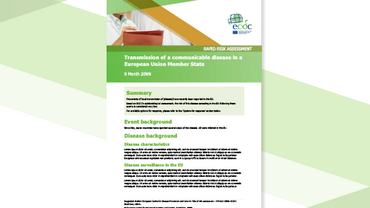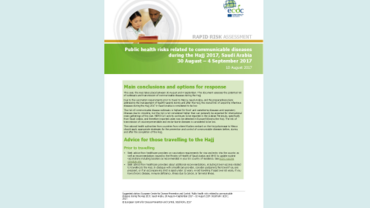Rapid Risk Assessment: Severe respiratory disease associated with Middle East respiratory syndrome coronavirus (MERS-CoV)
Currently, the risk of human infections and sustainable human-to-human transmission in Europe remains low. However, the number of human MERS cases reported from the Arabian Peninsula has increased rapidly in the past few months. Specifically, several healthcare associated clusters in Saudi Arabia and UAE have been reported which have been responsible for large numbers of cases. Given the current increase in nosocomial infections and travel-associated cases of MERS in the Arabian Peninsula, and the large number of people travelling between the Arabian peninsula and Europe, it is likely that more cases will be imported and detected in the EU/EEA. Continued vigilance in assessing patients with travel history to the affected region is warranted.
Executive Summary
Currently, the risk of human infections and sustainable human-to-human transmission in Europe remains low. However, the number of human MERS cases reported from the Arabian Peninsula has increased rapidly in the past few months. Specifically, several healthcare associated clusters in Saudi Arabia and the United Arab Emirates (UAE) have been reported which have been responsible for large numbers of cases. Given the large number of people travelling between the Arabian Peninsula and Europe, it is likely that more cases will be imported and detected in the EU/EEA. Continued vigilance in assessing patients with travel history to the affected region is warranted.
Since the previous (ninth) ECDC rapid risk assessment on MERS-CoV was published on 24 April 2014, it has become clear that false negative results cannot explain the increase in cases and it is unlikely that mutations have led to increased human-to-human transmission. Three other scenarios likely to play a part in the current epidemiology are:
- increased zoonotic transmission leading to increased introductions to community and healthcare facilities;
- suboptimal infection control in hospitals;• a more sensitive case detection algorithm used in some areas that has led to the current increase in number of cases.
In addition, there is an increasing body of evidence that dromedary camels are the direct or indirect source of infection for many of the human cases.
Options for action
The updated rapid risk assessment contains options for action in the following areas:
- Travel advice: there are no travel restriction in place, however those travelling to the region should consult a doctor if suffering from a severe medical condition; avoid travelling if ill with an infectious disease; ensure good hygiene practices; avoid contact with animals, especially camels, and not consume unpasteurised milk or undercooked meat.
- The international public health community could consider providing further outbreak assessment support to better understand modes and sources of transmission, determine optimal management of patients and encourage serological surveys.
- EU/EEA Member States could review their preparedness in the event of a large MERS cluster; sensitise public health professionals and healthcare workers to the possibility of MERS presenting in returning travellers and increase awareness of the available testing, infection control, surveillance and reporting guidance.







